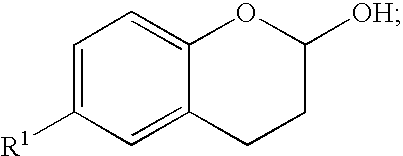Methods for producing amino substituted chromanes and intermediates thereof
a technology of amino substituted chromanes and intermediates, which is applied in the field of production of chromane compounds, can solve problems such as not scaling well commercially
- Summary
- Abstract
- Description
- Claims
- Application Information
AI Technical Summary
Benefits of technology
Problems solved by technology
Method used
Image
Examples
example 1
Production of 2-hydroxymethyl-4-nitrophenol
To a BH3.THF solution (110 mL, 1M, 110 mmoles) was added dropwise a solution of 5-nitro-salicylic acid (10.0 g, 54.6 mmoles) in 930 mL THF. After a few milliliters, the reaction mixture was cooled with ice to maintain a temperature of about 15° C. The clear brown solution was warmed to room temperature and stirred for an additional 7 hours. During this time a precipitate formed. BH3.THF (20 ml, 20 mmoles) was added and stirring was continued overnight. The mixture was cooled to 5° C. and carefully hydrolyzed with 1 M HCl (100 mL). Methyl tert-butyl ether (MTBE) (100 mL) was added, the phases were separated and the aqueous layer was extracted with MTBE (2×70 mL). The combined organic layers were dried over MgSO4 (10 g), filtered and evaporated to give 10.5 g of a pale ochre solid. This solid was recrystallized from 65 mL toluene to give 7.033 g (76%) of 2-hydroxymethyl-4-nitrophenol as a pale ochre solid.
1H-NMR (300 MHz, DMSO) δ=4.67 (s, 2H)...
example 2
Production of 2-chloromethyl-4-nitrophenol
The 2-hydroxymethyl-4-nitrophenol of Example 1 was added to a reaction flask with 200 mL of THF under nitrogen with stirring and heated to reflux while being vented to a scrubber system for efficient removal of HCl and SO2 gases which are eliminated. Thionyl chloride was slowly added dropwise with stirring, and the reaction was monitored with HPLC to indicate when halogenation of the hydroxymethyl group was complete (about 12 hours). The THF solvent was evaporated under vacuum and dried overnight to provide a yellow powder of substantially pure 2-chloromethyl-4-nitrophenol (about 95% yield).
1H-NMR (300 MHz, CDCl3) δ=4.67 (s, 2H), 7.01 (d, 1H, J=8.9 Hz), 8.05 (dd, 1H, J=2.8 Hz), 8.23 (d, 1H, J=2.8 Hz).
example 3
Production of 2-chloromethyl-4-nitrophenol
A 5-necked flask equipped with mechanical overhead stirrer, gas inlet tube, reflux condenser and a thermometer was charged with 4-nitrophenol (100 g, 0.72 mol). Concentrated HCl 932%, 1.3 L), conc. H2SO4 (98%, 10 mL) and formaldehyde dimethylacetal (152.4 g, 2 moles) were added and the mixture was heated to 70° C. Gaseous HCl was bubbled through the mixture for 4 hours. During this time a thick white precipitate formed. The suspension was cooled to 0° C., the precipitate was isolated by vacuum filtration and the yellow powder was dried over night under vacuum to give 108.76 g of slightly impure 2-chloromethyl-4-nitrophenol (about 76% yield).
1H-NMR (300 MHz, CDCl3) δ=4.67 (s, 2H), 7.01 (d, 1H, J=8.9 Hz), 8.05 (dd, 1H, J=2.8 Hz), 8.23 (d, 1H, J=2.8 Hz).
PUM
| Property | Measurement | Unit |
|---|---|---|
| enantiomeric purity | aaaaa | aaaaa |
| enantiomer | aaaaa | aaaaa |
Abstract
Description
Claims
Application Information
 Login to View More
Login to View More - R&D
- Intellectual Property
- Life Sciences
- Materials
- Tech Scout
- Unparalleled Data Quality
- Higher Quality Content
- 60% Fewer Hallucinations
Browse by: Latest US Patents, China's latest patents, Technical Efficacy Thesaurus, Application Domain, Technology Topic, Popular Technical Reports.
© 2025 PatSnap. All rights reserved.Legal|Privacy policy|Modern Slavery Act Transparency Statement|Sitemap|About US| Contact US: help@patsnap.com



